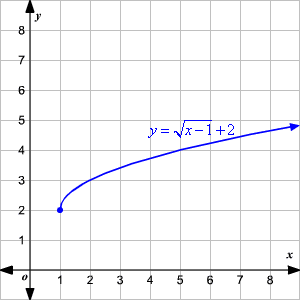Simplfiy: √(128x^5)
8x^2√(2x)
1. Is this an exponential or logarithmic function?
2. What is the EQUATION of the vertical asymptote here?
1. log
2. x = -4
Write the explicit formula for this sequence:
-5.4, - 1.8, 1.8, 5.4, ...
a_n = -5.4+3.6(n-1)
Factor this:

(3x+2)(x-3)
cos(210)
-√3/2
What is the domain and range of this function? 
Domain: [1, ∞)
Range: [2, ∞)
What are the ordered pairs for the following function after applying all of the transformations?
-3(2)^(x-1)+4
(0, 2.5)
(1, 1)
(2, -2)
Evaluate:

67
Find the LCD

(x+5)(x+8)(x-3)
sin(690)
-1/2
Rationalize the following:
(x+8√2x+8)/(x-8)
Expand the following completely:

4[ln(3)+2ln(y)-1/2ln(x)]
4ln(3)+8ln(y)-2ln(x)
Find the number of terms in the following sequence:
2/9, 2/3, 2, 6, ..., 13122
11 terms
Simply completely

(2x+12)/(3x-2)
What is the reference angles for 19pi/6
pi/6
Solve

p = 1, 2
Solve:
x = 3
Find the sum of the first 50 terms of the arithmetic sequence whose general term is

Simplify: 
(x+1)/(x+2)
1/√3
Solve:
x=4
Solve:
1-log(7+x)=log(x-2)
x=3
Calculate the following summation:

hint: you do not need to find allll 100 terms!
20,700
Solve:

y = 4
Graph 17𝝅/5 in standard position and state the reference angle.
The terminal side is in the 3rd quadrant, closer to the y-axis. It spins around one full time and then almost 75% of the way. Reference angle: 2𝝅/5